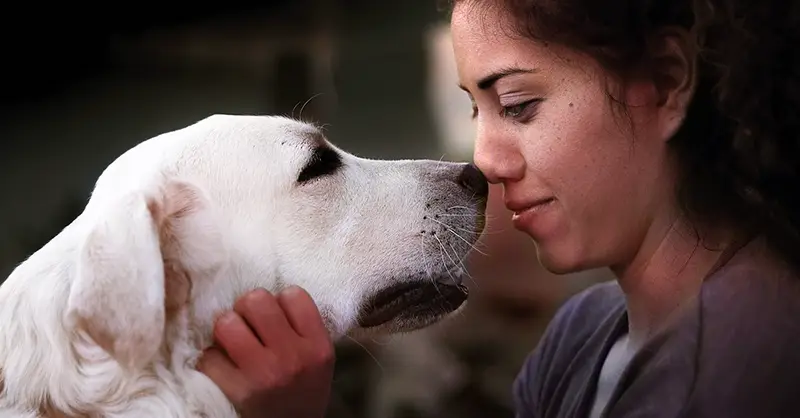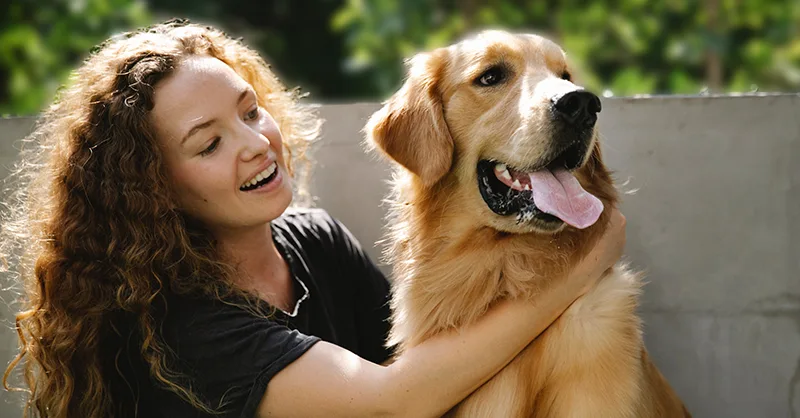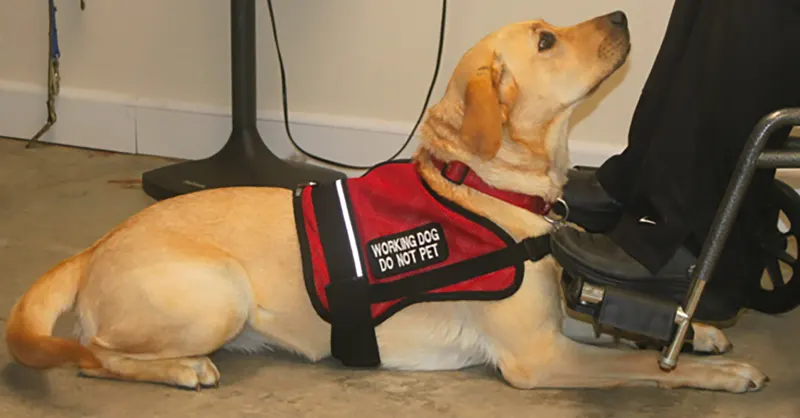Archive for the ‘Psychiatric Service Dog’ Category
Debilitating anxiety can make everyday tasks difficult to manage. It can be a struggle to go out in public, attend social events, or even complete simple tasks like grocery shopping. For those who experience anxiety that affects their daily life, a service dog can be a game-changer.
Psychiatric Service Dogs for AnxietyA service dog is a highly trained animal that assists individuals with disabilities. In the case of debilitating anxiety, a service dog can be trained to provide comfort, support, and a sense of security.
Service dogs that assist with mental health conditions are known as psychiatric service dogs. These dogs can detect changes in their handler’s behavior and take appropriate action to alleviate their symptoms.
To qualify for a service dog, your anxiety must severely impact a major life activity. The Americans with Disabilities Act (ADA) defines a qualifying psychiatric disability as one that “substantially limits a major life activity.” That means a person’s anxiety must be so chronic and intense that it limits their ability to complete important life activities like working, attending school, or caring for oneself.
How a Service Dog Helps with AnxietyOne way a service dog can help someone with debilitating anxiety is by providing a calming presence. Just having the dog nearby can make the person feel more secure and less anxious. The dog can provide a sense of grounding, helping the individual feel more connected to the present moment.
However, a dog that solely provides comfort through its presence is likely an emotional support animal and not a service dog. Service dogs, by definition, must be individually trained to perform specific tasks related to their handler’s disability.
For example, if the person experiences panic attacks, the dog can be trained to recognize the signs of an impending attack and take action. This may include nudging the person to get their attention, providing deep pressure therapy, or leading them to a quiet place where they can calm down.
Another way service dogs can help those with debilitating anxiety is by providing social support. Going out in public can be challenging for individuals who struggle with social anxiety. Having a service dog by their side can make it easier to navigate social situations.
In addition to providing emotional support, service dogs also assist their handlers with practical tasks. For example, the dog can be trained to retrieve medication or a water bottle during an anxiety attack. They can also be trained to alert their handler when they sense an oncoming panic attack, allowing the person to take appropriate steps to manage their symptoms.
Verifying a Psychiatric Service DogPsychiatric disabilities are not visible like other disabilities might be. As a result, third parties have the right to verbally confirm whether you have a service dog. To verify a service dog, staff at a public venue can ask two questions:
Is the dog a service dog required for a disability? and What work or task has the service dog been trained to perform?Most service dog owners use accessories like ID cards, vests, certificates, and tags to visually denote that their dog is a service animal. Note, however, that third parties cannot insist on these items as a condition of entry. Service dog owners use them at their discretion.
If you are planning to fly with your psychiatric service dog, you should be prepared to complete the DOT’s Service Animal Air Transportation Form.
PSD owners can also obtain PSD letters from their licensed healthcare professional. A PSD letter is a document establishing that a person has a qualifying mental health disability.
Talk to a licensed healthcare professional in person or online if a psychiatric service dog could help deal with your anxiety. See if your mental disability qualifies for a psychiatric assistance dog. Get an PSD Letter assessment from a licensed healthcare professional.How does someone prove they own a psychiatric service dog (PSD), not just a regular everyday pet? The law limits the ways someone can ask about your service dog. This is to protect the privacy of handlers while also ensuring they have a clear way to prove their need for a PSD.
Under the Americans with Disabilities Act (ADA), if you’re out in public or at a hotel, store, or other venues, a staff person can verify your canine is a psychiatric service dog by asking two questions:
Is the dog a psychiatric service dog required because of a disability? What work or task has the PSD been trained to perform?You do not have to specifically identify your disability or demonstrate the task your PSD has been trained to perform.
ServiceDogCertifications.org
Typically, only verbal verifications of service dogs are allowed. The major exception is air travel. If you’re flying with your psychiatric service dog, airlines will ask you to submit the DOT’s Service Animal Air Transportation Form. Airplane and airport staff can also ask the two questions above to verify a dog is a PSD.
For a guide to flying with a service dog, click this link.
The U.S. Department of Transportation (DOT) has stated that airlines can also observe the dog’s behavior to see whether it remains under the handler’s control. If the dog is disruptive or out of control, that may be evidence the dog has not been successfully trained to be in public.
The DOT also allows airlines to look at paraphernalia such as harnesses, vests, and tags to determine whether a dog is a PSD. These items can help signal that your dog is a PSD and is one indicator airline staff can consider to determine whether a dog is a service animal. PSD owners find these accessories especially useful because they suffer from mental health disabilities that are not visible.
Having a PSD outfitted with appropriate paraphernalia helps to cut off unwanted approaches from strangers and broadcasts that the dog is on duty. Keep in mind, however, that accessories alone do not make a PSD – that comes from proper service dog training.
Research into the human-dog bond confirms how humans benefit from the relationship. Service dogs used to help with mental health conditions are also known as psychiatric service dogs (PSD) and utilize this human-dog bond. PSDs help fulfill tasks that individuals with severe anxiety would generally feel too overwhelmed to perform or can provide actions to prevent or reduce symptoms of anxiety as they occur.
Service Dogs for AnxietyAnxiety is the most common mental health condition in the U.S., with approximately 40 million adults experiencing the disorder. Anxiety can become overwhelming and prevent a person from performing major life tasks. In cases where a person with anxiety is unable to function at work, school, or in social situations, a service dog can help them overcome their anxiety.
A service dog is a highly trained dog that can perform specified tasks or services that the individual with a disability may not be able to accomplish on their own. Service dogs are also legally allowed to follow their owners into establishments that are not usually open to animals.
Physiological and Psychological Response to AnxietyAnxiety stems from a physiological response. The brain gauges situations as dangerous, even when they aren’t or if the danger has long gone. The brain then starts the stress reaction (a so-called “fight or flight” response) and releases hormones into the body. These hormones initiate the physical effects: hyper-awareness, rise in blood pressure, sweating, increase in heart rate, and quick breathing.
The physiological response from anxiety can be detrimental to the body if experienced for lengthened periods. This response can also result in a state of panic that prevents a person from executing necessary activities. Anxiety can also cause insomnia, depression, and anger management issues.
Research has shown that trained psychiatric service dogs can help humans overcome anxiety in several ways:
Lower blood pressure and heart rate Provide a calming influence Function as a protective factor against suicide and self-harm Provide a sense of security Fetch any medication or devices that may help reduce the symptomsIt is important however to recognize that in order to qualify as a service dog, there must be a need for the dog to perform a job or task relating to a person’s disability. If the dog is merely providing comfort for anxiety that qualifies as a disability, it is likely an emotional support animal and not a psychiatric service dog.
Anxiety as a DisabilityAccording to the Americans with Disability Act (ADA), a person with a disability meets one or more of the following criteria:
A physical or mental impairment that severely impacts the ability to perform one or more major life functions A past impairment that meets the previous description Is regarded by others as having an impairment that meets this descriptionMany disabilities are not visible to others, meaning that the disability may not be readily apparent, like a physical impairment or injury. Many disabilities are neurological or psychological and can’t immediately be deducted.
Anxiety can be an example of one of these “invisible disabilities.” If anxiety causes impairment in a major life function such as work, school, or personal relationships, then may meet the definition of a disability.
Some forms of anxiety can be very debilitating. Phobias and obsessive-compulsive disorders are a form of anxiety. Phobias often prevent people from completing necessary life tasks such as traveling, being in public areas, or having social interactions. In these cases, because it impacts major life activities, anxiety may meet ADA’s definition of a disability.
A healthcare provider can help someone determine if their anxiety rises to the level of a disability. In addition, it’s worth repeating that even if a person has an anxiety disorder that qualifies as a disability, a psychiatric service dog is only appropriate if they need a job or task performed to assist with that disability. If task-trained dog is not required, it is more appropriate to seek qualification for an emotional support animal.
Wonder if you qualify for a Psychiatric Service Dog?Get an assessment from a licensed medical health professional. If you qualify, they can issue a PSD Letter so that you can confidently train and own a PSD. How can a service dog be obtained for anxiety?Only dogs can legally be considered service animals and meet ADA requirements to enter areas with their owners.
The following are two qualifications to establish before getting a service dog:
The level of anxiety must qualify as a disability: A service dog can be obtained for anxiety if the condition is an impairment that substantially limits one or more major life activities. Establishing a need for a service dog: A service dog must also be able to provide a task that the person with anxiety is unable to do. The dog must be able to perform a task that directly relates to the stated disability.A licensed mental health professional or medical doctor can provide an assessment regarding whether a person’s anxiety is a disability. If deemed a disability, a PSD letter can be issued. Even though the PSD letter is not required to get a service dog for anxiety, many individuals with anxiety find it reassuring to have a letter from a licensed therapist that confirms their need for a psychiatric service dog.
Getting a service dog for anxiety can be a long process. There are PSDs that are already trained to be service dogs, but there may be a waitlist for such dogs. And even after receiving the service dog, further training alongside the handler may be necessary in order to make the dog sensitive to their specific handler’s needs.
Handlers can also select an untrained dog and conduct all the necessary training themselves. The ADA allows for self-training of service animals. Either way, it will take time and patience until the psychiatric service dog is fully trained and ready for duty.
Keeping a training log will help with analyzing the progress of your service dog’s training. Download this free sample Service Dog Training Log, provided by Service Dog Certifications.
Service Dog Owner ResponsibilitiesBeing a service dog handler comes with many responsibilities. Because service dogs can accompany their handler in public places where pets are not allowed to go, the handler must be comfortable and confident that their dog will behave at all times. The service dog must be able to focus on their tasks at all times, even in unfamiliar and busy places. If the handler loses control of their service dog, or the dog appears like a danger to other members of the public, it may lead to the removal of the dog. Service dog owners must ensure that their animals are safe, clean and well provided for at all times.
ConclusionObtaining a psychiatric service dog for anxiety is possible, though it may take time and patience until a suitable dog is fully ready for their job. But for all the benefits and possibly life-changing qualities a service dog for anxiety provides, it can be well worth the effort! If you think a service dog is appropriate for your psychiatric condition, speak to a licensed healthcare professional to see if you have a qualifying disability as a first step.
See if your mental or emotional disability qualifies for a psychiatric assistance dog. Get a PSD Letter assessment from a licensed medical professional.






